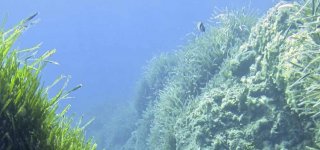The seagrass Posidonia
Often called the "lungs of the Mediterranean" Posidonia is an endemic aquatic plant that is one of the most important treasures of the Mediterranean Sea. It flourishes in coastal areas, the first meters deep and up to about 40 m depth. Posidonia is one of the most important sources of oxygen in the Mediterranean. It therefore represents a local environmental issue but also on a much larger scale, given that most of the oxygen that keeps us alive comes from the seas and oceans of our planet. With an output of up to 20 liters of oxygen per day per m2, the Posidonia Mediterranean is a source of life importance. Like some other valuable ecosystems such as mangroves and salt marshes, seagrass Posidonia capture and store large amounts of carbon, playing a role in the fight against global warming.
Posidonia seagrass, these coastal seagrass meadows in the Mediterranean, have other crucial functions for the marine ecosystem. They include a stabilizing role of marine soils, they also protect from erosion. Herbaria cushion to swell approaching the coast, thus preserving the shoreline and safe parts of the coastline in rough sea.
Very sensitive to pollution, Posidonia is a referent plant to measure the state of health of Mediterranean waters. His health is good indicator to know the state of water pollution, locally and more generally.
The net decrease in Posidonia meadows in the Mediterranean over the last century and more accelerated in the last fifty years raises serious concerns. The threat to this precious ecosystem is due to the joint action of water pollution, urbanization of coasts, fishing and tourism boats.
Posidonia meadows in the ecosystem of great wealth. Nearly 25% of Mediterranean fauna find refuge: many marine species live permanently in the seagrass Posidonia, others come for food or to breed. Cuttlefish, bream and bream, like many other marine animals spend the first days of their lives. Natural Nursery, Posidonia herbarium is a paradise for divers, who can observe an incredible concentration of species. Present from the first meters deep, the herbarium at Posidonia can also discover when trekking in fins, mask and snorkel. Among the specimens to observe include sea oranges, endemic sponges from the Mediterranean that attach to the rhizomes of Posidonia, or even mendoles groups.
It speaks of "herbal" because Posidonia is a plant, not an algae. Composed of roots, rhizome and leaves, also produces flowers and fruit for its reproduction. Flowering is however highly dependent on external conditions such as temperature of the water. The small fruit which then form the appearance of a small olive. It is not rare to find on the beaches in the spring. Other traces of Posidonia observing on the beaches are the balls of fibers that form in sea currents after the decomposition of the plant. In early fall, the first rough seas bring beach debris Posidonia leaves thick benches. These will protect the coastline from erosion by waves during the winter and the storm season.
Dried Posidonia leaves were once used to make thatched roofs in Corsica, in North Africa, including Egypt. In Italy, Murano glassmakers used them to protect their creations during transport. They could also be used as a bench or as bedding for livestock.
